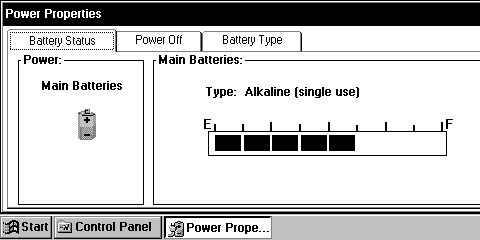
HP320LX
I have recently been taking a look at a Hewlett-Packard HP320LX. It appeared in the high street shops shortly before the Psion Series 5 launch, and in many ways is the obvious competitor to it. The street price is slightly higher than the Psion, but the shops have stocks of the HP when they don't of the Psion.
It is interesting to compare the HP320LX directly against the earliest of the CE machines to appear, the Casio Cassiopeia. The Cassiopeia was never officially available in this country, although it has been freely available to anyone with either a web browser or who can reach London's Tottenham Court Road. Although it had some nice touches, like the flashing light on the outer casing integrated with the Calendar application, the Cassiopeia is generally regarded as a poor implementation of the CE standard, and the HP320LX as one of the very best.
The HP320LX is slight larger and heavier than the Cassiopeia, making it significantly bigger than the Psion Series 5, which is smaller and lighter than both. The reset button is tucked underneath the backup battery cover, rather than on the main keyboard, reflecting the greater confidence in reliability that Hewlett-Packard would no doubt like to project. The main battery cover is loosely attached, and will drop off with a light tap in the wrong place, in marked contrast to the system of switches needed to release the Cassiopeia's cover. The keyboard of the HP320LX is larger and more distinct than that of the Cassiopeia, with a slightly better feel; but nowhere near the league of the Series 5. The HP Enter key is only slightly larger than a normal key, whereas the Casio has a proper L shaped Enter key. Touch typing is a borderline possibility on both of these machines, but it helps if you have very small fingers.
The HP320LX is supplied with both a charger and a desktop stand coupled with serial cable; the Cassiopeia only comes with a serial cable. The HP also has a single slot for Compact Flash Memory cards.
The HP screen is about as murky as the Casio's, and just as reflective, but the HP backlight is much brighter. Bright backlights aren't always better than dimmer ones, but I'd say the HP backlight made the display more legible under normal conditions. The HP screen is also very much bigger than the Casio's at 640x240, which is the big selling point HP are making with the HP320LX. However, it was very much harder to make sufficient contact with the stylus on the HP320LX to click on a button or icon.
Both models claim to be running Windows CE 1.0. The main applications (InBox, Pocket Word, Pocket Excel, Pocket Internet Explorer) are all pretty much the same, although the HP versions of Word, Calendar, Contacts and Tasks have a print option, and the Casio versions do not. The Casio has an option to set the flashing light for reminders in both Calendar and Tasks.
Where the differences really show up are in the Setting control panel. The HP320LX has, in addition to all the options that the Casio has options for Data Backup and Regional Settings, and a number of detail differences on the individual panels. Data Backup is an option to save and restore data to an internal or external memory file. Regional Settings cover date and number formats.
The best improvment in the HP320LX

The biggest and most useful change to Settings is in the Power Properties dialog. Instead of just two discernible battery levels (Good or Very Low), the HP320LX uses eight blocks to show the level of the main battery (but sticks to the same two levels for the backup battery). It also displays the type of battery installed (Alkaline, in my case), selected from an extra panel from a choice of Alkaline or Nickel Cadmium. A check box allows you to enable recharging for NiCad batteries. The Power Off dialog panel on the HP320LX has a check box to allow turning on when the screen is touched.
At the launch of the HP320LX and HP300LX models in the UK, there was talk that HP would be using Windows CE 1.1, with support for the larger screen type, localisation, and better power management. This would certainly seem to be the case, except that for some reason it isn't called CE 1.1, but is just CE 1.0 with a bigger build number. The localisation options are important, of course, but I really do think that the best improvement of all is without question the extra resolution on the battery level meter. You can't imagine how frustrating it is to have only two levels shown, as with the Casio, until you first have the machine die on you during a day that started with the battery level at 'Good'.
One other difference I found was that the CE PowerToys don't work reliably with the HP320LX. Most of the utilities are OK, but the Remote Control utility was very unreliable, and would crash more often than not. When it did work, only part of the screen was captured. As a consequence, I don't have as wide a selection of screen shots for you as I would like.
I don't find the HP320LX to be much better than the Casio; the larger screen and Compact Flash slot are better features to have; but it has disadvantages, too, like the annoyingly slow screen click. The Philips Velo is better than either, on paper. We will have to wait for its rumoured September launch in a European version to see how it stacks up.
Words and design by:
Paul Lynch
Last updated: September 8, 1997